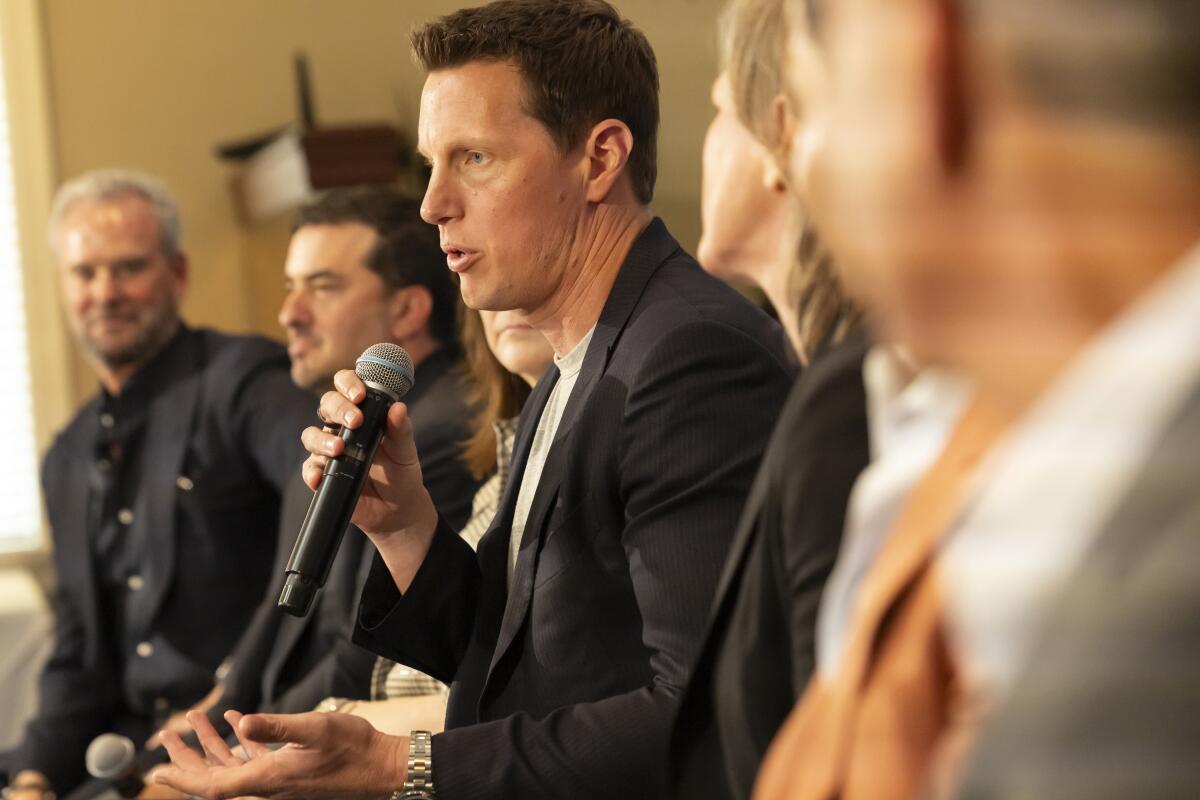UCLA’s dismal defense in comeback over Cal Poly raises questions
UCLA had just put on a dazzling offensive display when a help-wanted sign went up in the postgame news conference.
The search for assistance came from a coach who knows his team can score but will need a lot better effort on the other side of the ball to get to where it wants to go this season.
“My biggest challenge with this team,” Mick Cronin said after the Bruins needed an epic scoring surge in the second half to post a relief of a 108-87 victory over Cal Poly, “is finding a guy or two or three that their mind is on defense.”
Nobody filled that role Friday night during a first half that led to scattered boos serenading the Bruins on their way to the locker room inside Pauley Pavilion.
UCLA was trailing by two points after putting in a low effort and playing just a sprinkling of defense against a mid-major team with a losing record from the Big West Conference.
The Cal Poly logo on the front of the opponents’ jerseys did not elicit the same sort of spirited effort the Bruins had given against more brand-name foes, continuing a troubling trend going back to the season opener.
“I definitely think that’s fair to say,” UCLA guard Skyy Clark said after notching a season-high 30 points while making six of 10 three-pointers and becoming the first Bruin in school history to make at least six three-pointers in back-to-back games. “That’s just something we gotta harp on as a team.”
The Bruins could exhale after going with a smaller lineup that produced 65 points in the second half, the most in a half by UCLA since it splurged for 66 in the second half against George Mason on Dec. 22, 1994.
But plenty of worries linger, most of them on the defensive end for a team that has given up an average of 78.2 points over its last six games.

This was another case of UCLA simply outgunning an opponent, the Bruins shooting 57.4% to Cal Poly’s 51% during a game in which defense was played only in spurts. How do the Bruins explain giving up 45 points in the first half?
“We’ve got too many guys who are conscientious objectors defensively,” Cronin said. “And if I can’t get those guys to quit protesting — they don’t say anything, but until they really believe that’s the way to win … ”
UCLA (9-3) prevailed only after Cronin went with a three-guard lineup, replacing center Xavier Booker with Jamar Brown to start the second half in an effort to combat the Mustangs’ drive-and-kick offense that stationed practically everyone behind the three-point line. With a more mobile lineup, the Bruins proceeded to go on a 15-0 run to transform a two-point deficit into a 60-47 lead, removing any doubt about the game’s outcome.
Clark continued his recent scoring spree and received plenty of help from forward Tyler Bilodeau (24 points and eight rebounds) and point guard Donovan Dent (16 points, 11 assists and five steals) as the Bruins notched a second consecutive victory.

UCLA guard Donovan Dent, center, dribbles past Cal Poly guards Guzman Vasilic, left, and Kieran Elliott to score during the second half Friday night.
(Damian Dovarganes / Associated Press)
Cayden Ward scored 21 points for Cal Poly (5-8), which had been given a 2% chance of winning, according to the metrics of basketball analyst Ken Pomeroy.
By the game’s midpoint, the possibility of a massive upset had crept uncomfortably upward for UCLA.
Giving up open shots as part of a lackluster defensive effort wasn’t nearly the worst of it for the Bruins.
Trent Perry twice fouled a three-point shooter, once prompting Cronin to yell, “Get over here!” after Perry sent Cayden Ward to the free-throw line for three shots. A new low came late in the first half when Brown fouled Hamad Mousa on a three-pointer that went in, Mousa making the free throw to complete a four-point play.
“Buddy, it’s the worst play in basketball, and I’ve gone literally years with that happening zero times,” Cronin said. “Nobody coaches that more than me. You are not allowed to foul a jump shooter if you play for me, never. Never. If you’re that close, that means the shot is contested. You could deduce that, right? So I don’t care if he makes it, he’s taking a contested shot. Jumping toward the guy, you’re going to land in his space.”
Brown was immediately replaced by Perry, whose defensive inattentiveness quickly reemerged when Ward beat him off the dribble for a one-handed dunk. Things improved considerably the rest of the way. Cronin said he continued to be pleased with Clark’s defense and was satisfied with the second-half effort of forward Eric Dailey Jr., who limited Mousa to only two of his 14 points after halftime.
Cronin suggested that he wanted this team to prioritize defense the way the Bruins did after halftime of their victory over Michigan State in the opening round of the 2021 NCAA tournament, which sparked a flurry of lockdown efforts leading to five consecutive wins.
“From that point on, it took a halfcourt shot to stop us from trying to win the title,” Cronin said, alluding to Jalen Suggs’ buzzer-beater in a national semifinal. “But if that wouldn’t have changed, we weren’t going anywhere, so you just keep trying to stay relentless with it.”

How does Cronin get his team to make that change?
“You play the guys who will do what you tell them to do,” Cronin said. “If you play guys who are conning you with their effort defensively, not only are you going to lose, then the other guys will start doing it because they think you’re a fraud because you’re playing them anyway.”
Applications are being accepted. The next opportunity to fill a heightened role comes Tuesday against UC Riverside.




